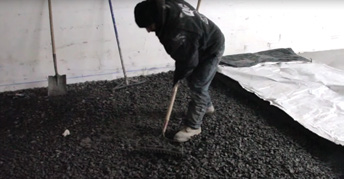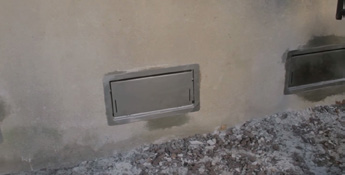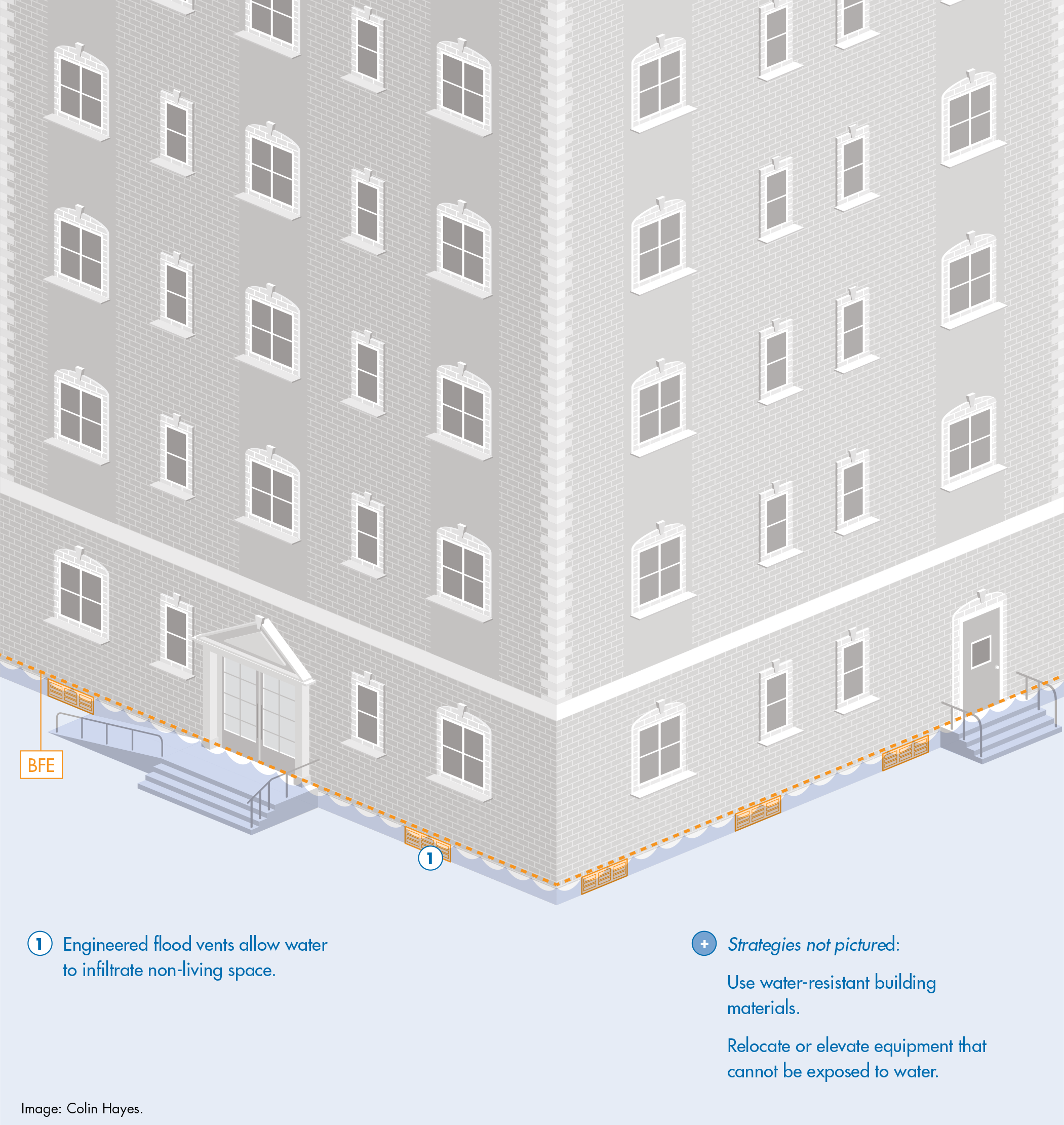
Description + function
FEMA defines wet floodproofing as “permanent or temporary measures applied to a structure or its contents that prevent or provide resistance to damage from flooding while allowing floodwaters to enter the structure or area. Generally, this includes properly anchoring the structure, using flood resistant materials below the Base Flood Elevation (BFE), protection of mechanical and utility equipment, and use of openings or breakaway walls.”
Strategy into action
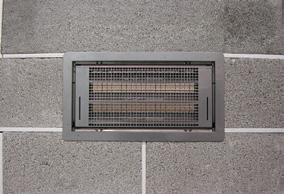
Wet floodproofing vents should be located below the BFE and no more than 1 ft. above the ground. (See Strategy: Elevated Equipment)
Electrical panels, mechanical equipment, gas and electric meters and shut-offs should be relocated from flood-prone areas to locations above the DFE. If that is not possible, they should be protected in place. (See Strategy: Dry Floodproofing.)
To avoid structural damage due to hydrostatic pressure during flooding, provide multiple vent openings through which floodwater can enter and exit.
To satisfy NFIP requirements, the entry points should be flood openings that meet NFIP requirements for number, size and location. Blockage of entries by flood debris must also be taken into consideration.
Building materials installed in floodable spaces—including framing, wallboard, flooring and ceiling paneling—should be able to survive water exposure without major damage, promoting mold or mildew, or absorbing contaminants. Building materials under the DFE should be able to withstand contact with flood waters for up to 72 hours without requiring more than cosmetic repairs.
In coastal areas with salt water, corrosion of metals may be a problem. Materials that might dry out and be usable after exposure to fresh water may be damaged beyond repair by salt water.
Operations + maintenance
Items used or stored in flood-prone basements or ground-floor spaces should be moved out of the building or to higher floors in advance of a flood. These include:
- Vehicles.
- Mechanical equipment including lawn mowers and snow blowers.
- Furniture.
- Area rugs.
- Residents’ belongings.
- Cleaning supplies and toxic chemicals.
How to quickly remove such items out of floodable spaces before a predicted flood should be clearly laid out in an emergency plan. (See Strategy: Developing an Emergency Management Manual).
Polluted floodwater poses a health risk to facility operators. Engage professional cleaning teams who have been trained and have equipment to mitigate exposure risk. Use commercial fans and dehumidifiers to dry out affected areas to prevent mold growth.
If soil is saturated during flooding, pumping out basements too quickly can lead to structural problems in foundations. If buildings share common foundation or party walls, and one flooded basement is pumped out while the adjacent basement is not, hydrostatic pressure on the common foundation wall can cause damage or collapse. See Resources for FEMA advice on pumping out basements.
Mold growth is a common problem after flooding. All materials in a flooded space should be dried as soon as possible. The space should be well-ventilated. Porous materials such as drywall, wood or carpeting will need to be discarded. Hardened, non-porous materials including plastic and glass may be cleaned with a commercial cleaner.
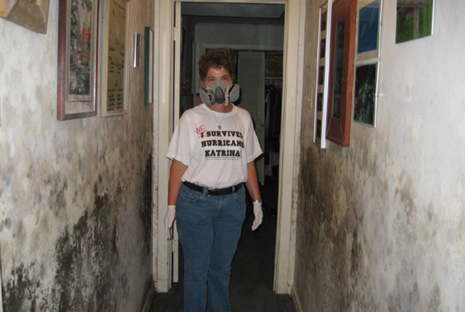
Estimated cost
- $
- $$
- $$$
- $$$$
Supporting strategies
Resources
-
Don’t Pump out Basements too Early or too Fast, FEMA.
www.fema.gov/news-release/2011/07/09/dont-pump-out-basements-too-early-or-too-fast -
Floodproofing: Techniques, Programs, and References, U.S. Army Corps of Engineers, May 2000.
cdm16021.contentdm.oclc.org/cdm/ref/collection/p16021coll11/id/359 -
Wet Floodproofing, NYC Department of Design and Construction Building Resilience Database.
ddc-resiliencedatabase.wikispaces.com/Wet+Floodproofing
Background
During Superstorm Sandy, Hoboken, NJ suffered heavy damage to its buildings and infrastructure, including this six unit multifamily building, 132 Jackson St., located in the AE flood zone. After the storm, the property faced escalating insurance costs.
Strategy
To mitigate future risk and reduce insurance premiums, the owner chose a wet floodproofing strategy, which added nine Smart Vents on the first floor and used 9 inches of gravel and concrete fill to raise the floor to ground level. To minimize heat loss during cold weather, the owner chose insulated Smart Vents.
Cost
Total cost of the renovation, including installation of Smart Vents and the first floor fill, was $25,000. The one-panel Smart Vents cost $200 to $250 each. the retrofit, the building experienced an 83 percent reduction in the cost of its flood insurance policy. Originally, the owner paid $12,000 for $300,000 worth of coverage; after the retrofit, their premium fell to $2,000 and coverage rose to $820,000. The owner experienced a return on investment in just two and a half years.
